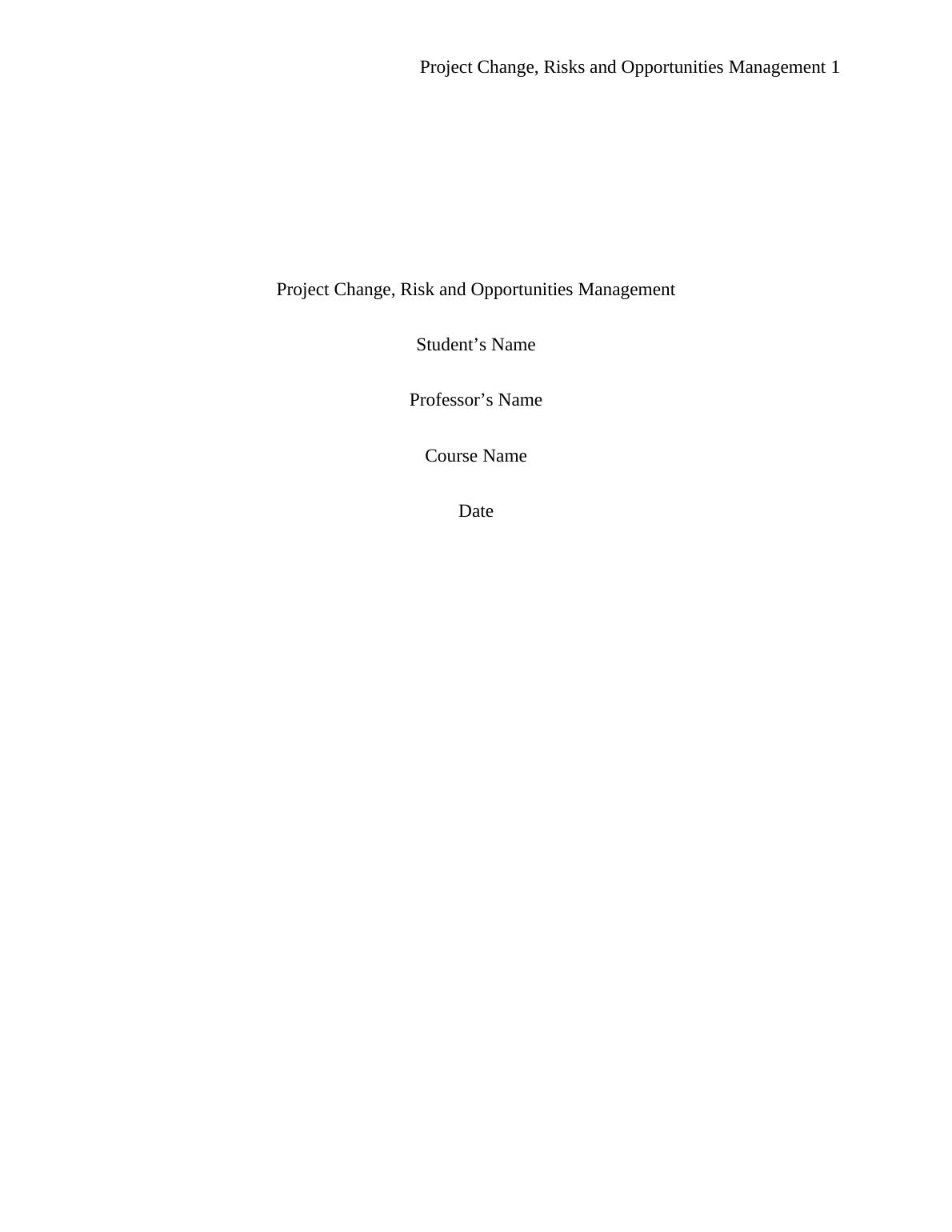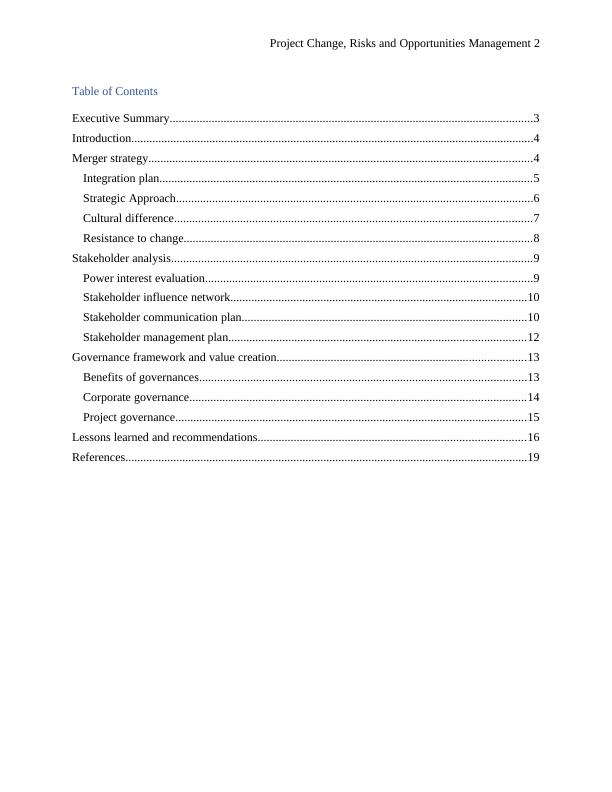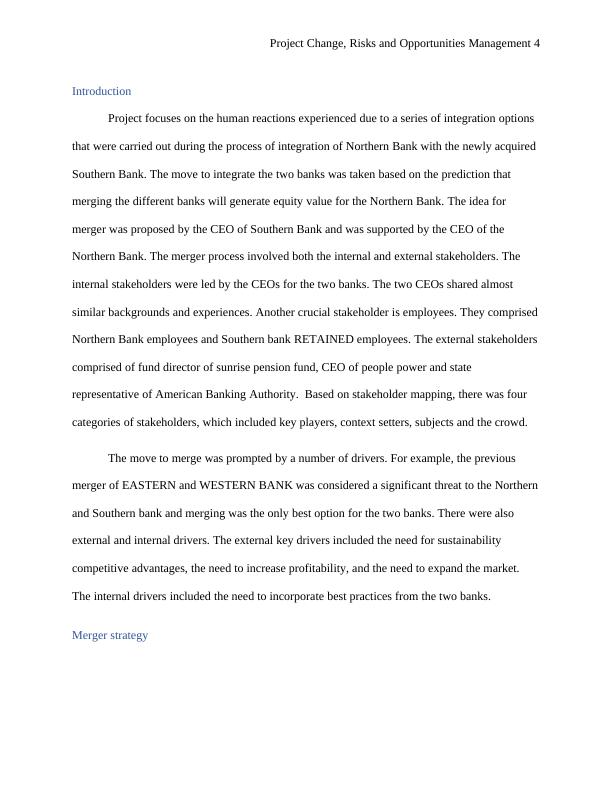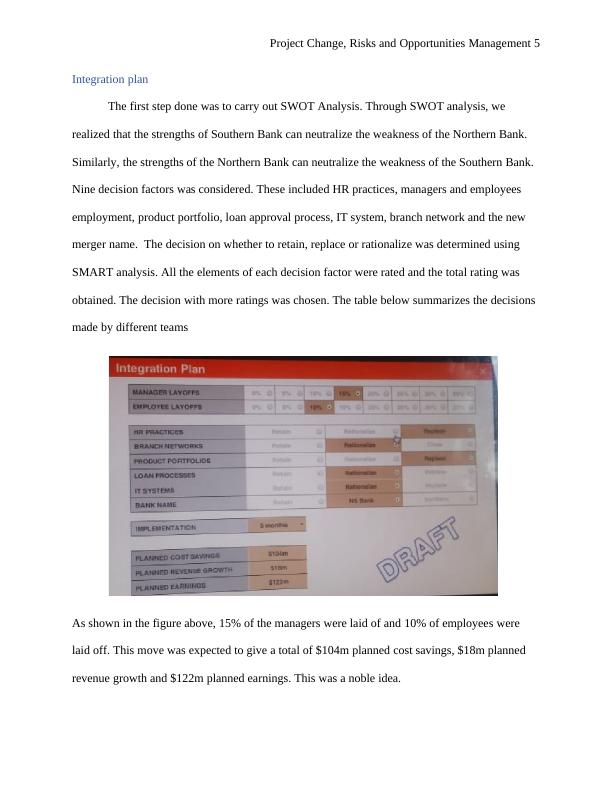Project Change, Risks and Opportunities Management
This report presents a strategic management plan for the merger of Northern Bank with the newly acquired Southern Bank.
23 Pages5733 Words71 Views
Added on 2022-11-25
About This Document
This document explores the challenges and opportunities in project change, risks, and opportunities management. It discusses the integration plan, strategic approach, cultural differences, resistance to change, stakeholder analysis, stakeholder communication plan, and stakeholder management plan. The document provides recommendations for better integration and lessons learned.
Project Change, Risks and Opportunities Management
This report presents a strategic management plan for the merger of Northern Bank with the newly acquired Southern Bank.
Added on 2022-11-25
ShareRelated Documents
Project Change, Risks and Opportunities Management 1
Project Change, Risk and Opportunities Management
Student’s Name
Professor’s Name
Course Name
Date
Project Change, Risk and Opportunities Management
Student’s Name
Professor’s Name
Course Name
Date

Project Change, Risks and Opportunities Management 2
Table of Contents
Executive Summary.........................................................................................................................3
Introduction......................................................................................................................................4
Merger strategy................................................................................................................................4
Integration plan............................................................................................................................5
Strategic Approach.......................................................................................................................6
Cultural difference.......................................................................................................................7
Resistance to change....................................................................................................................8
Stakeholder analysis........................................................................................................................9
Power interest evaluation.............................................................................................................9
Stakeholder influence network...................................................................................................10
Stakeholder communication plan...............................................................................................10
Stakeholder management plan...................................................................................................12
Governance framework and value creation...................................................................................13
Benefits of governances.............................................................................................................13
Corporate governance................................................................................................................14
Project governance.....................................................................................................................15
Lessons learned and recommendations.........................................................................................16
References......................................................................................................................................19
Table of Contents
Executive Summary.........................................................................................................................3
Introduction......................................................................................................................................4
Merger strategy................................................................................................................................4
Integration plan............................................................................................................................5
Strategic Approach.......................................................................................................................6
Cultural difference.......................................................................................................................7
Resistance to change....................................................................................................................8
Stakeholder analysis........................................................................................................................9
Power interest evaluation.............................................................................................................9
Stakeholder influence network...................................................................................................10
Stakeholder communication plan...............................................................................................10
Stakeholder management plan...................................................................................................12
Governance framework and value creation...................................................................................13
Benefits of governances.............................................................................................................13
Corporate governance................................................................................................................14
Project governance.....................................................................................................................15
Lessons learned and recommendations.........................................................................................16
References......................................................................................................................................19

Project Change, Risks and Opportunities Management 3
Executive Summary
A merger between the Northern Bank and Southern Bank was conducted. The merger
was accompanied by integration plan that included employees and managers lay off, replacement
of HR practices, creation of branch network, slight adjustment of product portfolio, replacement
of loan approval process, replacing IT system, changing the bank name to NS Bank. It was
planned that all these changes should be completed within a period of six months (Between 6
November and 22 December). The purpose of integration plan was to harmonize the operations
of the two banks in the most profitable way possible. SMART analysis was done to determine on
whether to retain, replace or rationalize the nine proposed decisions. All the elements of each
decision factor were rated and the total rating was obtained. The decision with more ratings was
chosen. After making decisions, the integration commenced and the stakeholder reactions and
behaviors were monitored through the six-month period. The reaction was measured in terms of
their communication behaviors and their participation. The report will explore the strengths,
weaknesses, challenges encountered during integration process and give the recommendation of
what should have been done better.
Executive Summary
A merger between the Northern Bank and Southern Bank was conducted. The merger
was accompanied by integration plan that included employees and managers lay off, replacement
of HR practices, creation of branch network, slight adjustment of product portfolio, replacement
of loan approval process, replacing IT system, changing the bank name to NS Bank. It was
planned that all these changes should be completed within a period of six months (Between 6
November and 22 December). The purpose of integration plan was to harmonize the operations
of the two banks in the most profitable way possible. SMART analysis was done to determine on
whether to retain, replace or rationalize the nine proposed decisions. All the elements of each
decision factor were rated and the total rating was obtained. The decision with more ratings was
chosen. After making decisions, the integration commenced and the stakeholder reactions and
behaviors were monitored through the six-month period. The reaction was measured in terms of
their communication behaviors and their participation. The report will explore the strengths,
weaknesses, challenges encountered during integration process and give the recommendation of
what should have been done better.

Project Change, Risks and Opportunities Management 4
Introduction
Project focuses on the human reactions experienced due to a series of integration options
that were carried out during the process of integration of Northern Bank with the newly acquired
Southern Bank. The move to integrate the two banks was taken based on the prediction that
merging the different banks will generate equity value for the Northern Bank. The idea for
merger was proposed by the CEO of Southern Bank and was supported by the CEO of the
Northern Bank. The merger process involved both the internal and external stakeholders. The
internal stakeholders were led by the CEOs for the two banks. The two CEOs shared almost
similar backgrounds and experiences. Another crucial stakeholder is employees. They comprised
Northern Bank employees and Southern bank RETAINED employees. The external stakeholders
comprised of fund director of sunrise pension fund, CEO of people power and state
representative of American Banking Authority. Based on stakeholder mapping, there was four
categories of stakeholders, which included key players, context setters, subjects and the crowd.
The move to merge was prompted by a number of drivers. For example, the previous
merger of EASTERN and WESTERN BANK was considered a significant threat to the Northern
and Southern bank and merging was the only best option for the two banks. There were also
external and internal drivers. The external key drivers included the need for sustainability
competitive advantages, the need to increase profitability, and the need to expand the market.
The internal drivers included the need to incorporate best practices from the two banks.
Merger strategy
Introduction
Project focuses on the human reactions experienced due to a series of integration options
that were carried out during the process of integration of Northern Bank with the newly acquired
Southern Bank. The move to integrate the two banks was taken based on the prediction that
merging the different banks will generate equity value for the Northern Bank. The idea for
merger was proposed by the CEO of Southern Bank and was supported by the CEO of the
Northern Bank. The merger process involved both the internal and external stakeholders. The
internal stakeholders were led by the CEOs for the two banks. The two CEOs shared almost
similar backgrounds and experiences. Another crucial stakeholder is employees. They comprised
Northern Bank employees and Southern bank RETAINED employees. The external stakeholders
comprised of fund director of sunrise pension fund, CEO of people power and state
representative of American Banking Authority. Based on stakeholder mapping, there was four
categories of stakeholders, which included key players, context setters, subjects and the crowd.
The move to merge was prompted by a number of drivers. For example, the previous
merger of EASTERN and WESTERN BANK was considered a significant threat to the Northern
and Southern bank and merging was the only best option for the two banks. There were also
external and internal drivers. The external key drivers included the need for sustainability
competitive advantages, the need to increase profitability, and the need to expand the market.
The internal drivers included the need to incorporate best practices from the two banks.
Merger strategy

Project Change, Risks and Opportunities Management 5
Integration plan
The first step done was to carry out SWOT Analysis. Through SWOT analysis, we
realized that the strengths of Southern Bank can neutralize the weakness of the Northern Bank.
Similarly, the strengths of the Northern Bank can neutralize the weakness of the Southern Bank.
Nine decision factors was considered. These included HR practices, managers and employees
employment, product portfolio, loan approval process, IT system, branch network and the new
merger name. The decision on whether to retain, replace or rationalize was determined using
SMART analysis. All the elements of each decision factor were rated and the total rating was
obtained. The decision with more ratings was chosen. The table below summarizes the decisions
made by different teams
As shown in the figure above, 15% of the managers were laid of and 10% of employees were
laid off. This move was expected to give a total of $104m planned cost savings, $18m planned
revenue growth and $122m planned earnings. This was a noble idea.
Integration plan
The first step done was to carry out SWOT Analysis. Through SWOT analysis, we
realized that the strengths of Southern Bank can neutralize the weakness of the Northern Bank.
Similarly, the strengths of the Northern Bank can neutralize the weakness of the Southern Bank.
Nine decision factors was considered. These included HR practices, managers and employees
employment, product portfolio, loan approval process, IT system, branch network and the new
merger name. The decision on whether to retain, replace or rationalize was determined using
SMART analysis. All the elements of each decision factor were rated and the total rating was
obtained. The decision with more ratings was chosen. The table below summarizes the decisions
made by different teams
As shown in the figure above, 15% of the managers were laid of and 10% of employees were
laid off. This move was expected to give a total of $104m planned cost savings, $18m planned
revenue growth and $122m planned earnings. This was a noble idea.

Project Change, Risks and Opportunities Management 6
Strategic Approach
As stated, the Northern Bank was merged with the Southern bank. Both banks omitted
their original names and adopted new name. The merger strategy was based on the concept of
strategic alliance. Strategic planning of mergers and acquisitions is a process of objective
comparison of existing types of business with those areas of the business that you can do with
the available resources. According to this approach, the merging firms has to compromise or
leave some of their strategic activities for better and superior ones. The better strategies were
determined based on SWOT and SMART analysis. If new industries promise higher profits, then
it is more reasonable to carry out a merger or acquisition, i.e. expand the business and move
resources to more efficient business areas (Focarelli, Panetta and Salleo, 2002). It was found the
strategic alliance the best approach because it allows the two companies work synergistically for
the common benefits. Strategic alliance was also appropriate because the strengths of Northern
Bank represented the weaknesses of southern bank and the strengths of southern bank
represented the weaknesses of northern bank. Although this was the best merger strategy, it is
not without challenges. In the case of a strategic alliance, mistrust and misunderstanding are
possible goals. When a large company buys a small strategic package participation in a small
company, then it can be considered as potential "aggressor", for this case the Northern Bank
because none of the Northern bank employees was laid off (Loderer, Stulz and Waelchli, 2016).
Cultural difference
Although the merger was designed to tap consolidate strengths and neutralize the
weaknesses of the two banks, cultural difference stood on way towards realization of this goal. A
major cause of difference is the fact that in Southern Bank, some employees were retained while
others lose their jobs. A number of pertinent cultural considerations must have been
Strategic Approach
As stated, the Northern Bank was merged with the Southern bank. Both banks omitted
their original names and adopted new name. The merger strategy was based on the concept of
strategic alliance. Strategic planning of mergers and acquisitions is a process of objective
comparison of existing types of business with those areas of the business that you can do with
the available resources. According to this approach, the merging firms has to compromise or
leave some of their strategic activities for better and superior ones. The better strategies were
determined based on SWOT and SMART analysis. If new industries promise higher profits, then
it is more reasonable to carry out a merger or acquisition, i.e. expand the business and move
resources to more efficient business areas (Focarelli, Panetta and Salleo, 2002). It was found the
strategic alliance the best approach because it allows the two companies work synergistically for
the common benefits. Strategic alliance was also appropriate because the strengths of Northern
Bank represented the weaknesses of southern bank and the strengths of southern bank
represented the weaknesses of northern bank. Although this was the best merger strategy, it is
not without challenges. In the case of a strategic alliance, mistrust and misunderstanding are
possible goals. When a large company buys a small strategic package participation in a small
company, then it can be considered as potential "aggressor", for this case the Northern Bank
because none of the Northern bank employees was laid off (Loderer, Stulz and Waelchli, 2016).
Cultural difference
Although the merger was designed to tap consolidate strengths and neutralize the
weaknesses of the two banks, cultural difference stood on way towards realization of this goal. A
major cause of difference is the fact that in Southern Bank, some employees were retained while
others lose their jobs. A number of pertinent cultural considerations must have been

End of preview
Want to access all the pages? Upload your documents or become a member.
Related Documents
Paper on Post-merger Analysis of Banklg...
|22
|4383
|711
Southern Bank Acquisition: Merging Strategic Functions of Eastern and Western Banklg...
|18
|3956
|304
Solutions to DaimlerChrysler’s Cross-Cultural Issueslg...
|4
|687
|499
